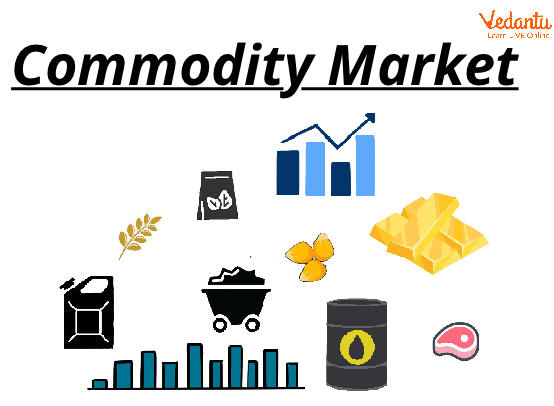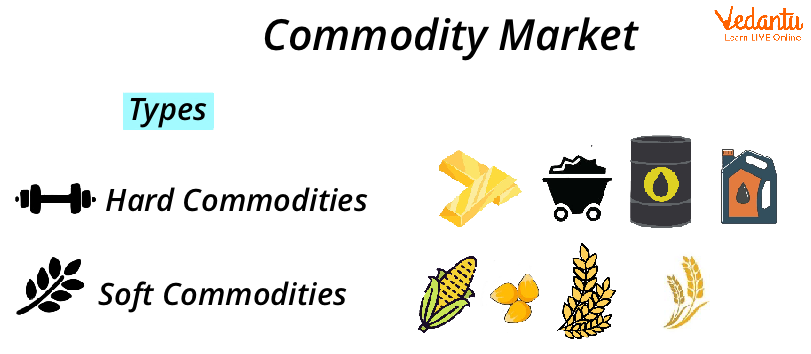




An Introduction to Commodity Market
The commodity market plays a crucial role in the world economy. Designing policy frameworks that support the economic goals of sustainable growth, alleviating poverty, inflation stability, food production, and climate change mitigation requires an understanding of what drives developments in these markets.
The macroeconomic influence of commodity markets on emerging markets and developing economies is varied, and the relationship between economic growth and commodity demand varies significantly between nations depending on their level of economic development.

Commodity Market
What is the Commodity Market?
A market where commodities are purchased and sold is referred to as a commodity market. Commodities are products or goods that can be exchanged on any global market. There are marketplaces for various raw resources, including wheat, steel, coffee, lumber, corn, oil, and other physical items like gold, silver, diamonds, and other precious metals.
Types of Commodities

Types of Commodities
Commodities can be categorised into two broad categories:
Hard Commodities: Hard commodities are those that are needed by the manufacturing sectors of the economy. These commodities are derived naturally. These are manually taken from the land or the water and should be mined.
Examples: coal, gold, crude oil, gasoline, rubber, etc.
Soft Commodities: Soft commodities comprise goods that are typically livestock or agricultural goods. In contrast to hard commodities, they are produced using suitable methods rather than being mined or extracted.
Examples: wheat, corn, barley, pork, tea, etc.
Commodities Traded in the Commodity Market

Commodity Traded in Commodity Market
The following are some commodities that are actively traded in the commodity market:
Energy: Due to the widespread distribution of electricity provided by power grids, developed nations have built markets where it is possible to sell electric capacity.
Lumber: Construction lumber in common sizes is traded on specialised marketplaces by specialised brokers. These markets are used by businesses that sell and buy lumber to reduce the amount of inventory that needs to be kept or to meet unexpected spikes in demand.
Wheat: Wheat is a crop that is grown all over the world and has always piqued the interest of investors because it is one of the most vital dietary ingredients. Without owning actual tonnes of wheat, traders can engage in the agricultural markets by trading wheat in the commodity market.
Stamps: Stamps that are considered collectable can be exchanged on active markets by investors and enthusiasts alike. Grading systems are used to determine the worth and condition of the stamps that are being traded.
Gold: The most valued of all precious metals, gold is bought for its beauty, liquidity, investment potential, and industrial properties. In times of economic unrest, gold is regarded as a safe haven commodity and as a hedge against inflation. Most newcomers and experienced traders alike prefer to invest in gold when it comes to commodities trading.
Coffee: The market for coffee is enormous. Coffee is a soft commodity and the second-largest commodity traded globally after oil. Other than water and tea, it is the most consumed beverage worldwide.
How are World Commodity Market Live Prices Decided?
Compared to financial assets, commodities are very volatile investments. They are influenced by natural elements like floods or calamities in addition to geopolitical conflicts, economic expansions, and recessions.
Similar to stock securities, the forces of supply and demand in the market essentially influence the price of commodities. For instance, in the live commodity US market, the price of a barrel of oil declines as the supply does. On the other hand, if demand for oil rises, the live commodity price of the US market does as well.
Two alternative methods are used to quote commodity prices. The market price or market futures price, which is the price that is reported in the news live, is the first. The cash cost of a commodity is its spot price, on the other hand. On the day of purchase, dealers paid this price for the commodity.
Case Study
The commodities exchange is the legal institution that determines, controls, and upholds the policies and processes for trading commodities, such as the standardised commodity contracts and other associated investment products. The trading of different commodities and derivatives takes place in an organised market.
One can trade commodities in India by visiting one of the more than 20 exchanges that make this possible, all of which are regulated by the Securities and Exchange Board of India. The market was governed by the Forward Markets Commission until 2015, when SEBI and it amalgamated to form a single regulatory framework for commercial investing.
1. How many commodity exchanges are there in India? Name some commodity exchanges for trading in India.
Ans. There are 22 separate commodities exchanges in India that were established by the Forward Markets Commission. There are 6 well-known commodity exchanges in India:
National Commodity and Derivative Exchange (NCDEX)
Multi Commodity Exchange of India (MCX)
National Stock Exchange (NSE)
Bombay Stock Exchange (BSE)
National Multi Commodity Exchange India (NMCE)
Indian Commodity Exchange (ICEX)
Summary
The commodity market is a market that involves buying and selling of raw materials and primary products. Commodities can be classified into two different categories: Soft Commodities and Hard Commodities. Soft commodities include agricultural goods, including sugar, corn, wheat, coffee, tea, and livestock. Hard commodities like metals, rubber, coins, and oil are mined or extracted. Energy, lumber, wheat, stamps, gold, and coffee are some of the actively traded comodities in the commodity market. The forces of demand and supply are the main factor in deciding the world commodity market's live price.
FAQs on Introduction to the Commodity Market
1. What are the types of commodity markets?
Commodities are generally traded on spot markets or derivatives markets.
1. Spot Markets: These are commonly referred to as "cash markets" or "physical markets," which are places where traders exchange physical goods for prompt delivery.
2. Derivatives Market: Commodity derivatives are financial instruments that let investors benefit from specific commodities without actually owning them. By purchasing a derivatives contract, a buyer obtains the right to exchange a commodity for a specific sum at a later time. Physical delivery of the commodity or other asset would not occur until the contracts expired, and traders frequently roll over or close out their contracts to avoid making or receiving delivery at all.
2. How do commodities markets operate?
The commodity market operates similarly to the other markets. You can purchase, sell, or exchange different commodities in this physical or virtual environment at the present time or in the future.
Futures contracts can be used in commodity trade as well. An agreement between a buyer and a seller known as a futures contract states that the buyer will pay the agreed-upon amount at the time of the transaction in exchange for the seller delivering the commodity at a certain future date. Thus, a farmer can purchase wheat futures to determine the price at which he wants to sell a specific quantity in the future. Similar to this, a trader may purchase or sell wheat futures for delivery at a price determined now.
3. Who are the participants of the commodity market?
The commodity market has two major participants:
1. Speculators: Speculators are traders that speculate on the future movement of prices and are always monitoring the price of commodities on the market. They are able to predict future price movements by continuously examining commodity prices.
2. Hedgers: Hedgers are manufacturers, and producers who use the commodity futures market to hedge themselves against risk are typically hedgers. Changes in goods prices, interest rates, and exchange value have an impact on many hedgers who are producers, wholesalers, retailers, or manufacturers.




































